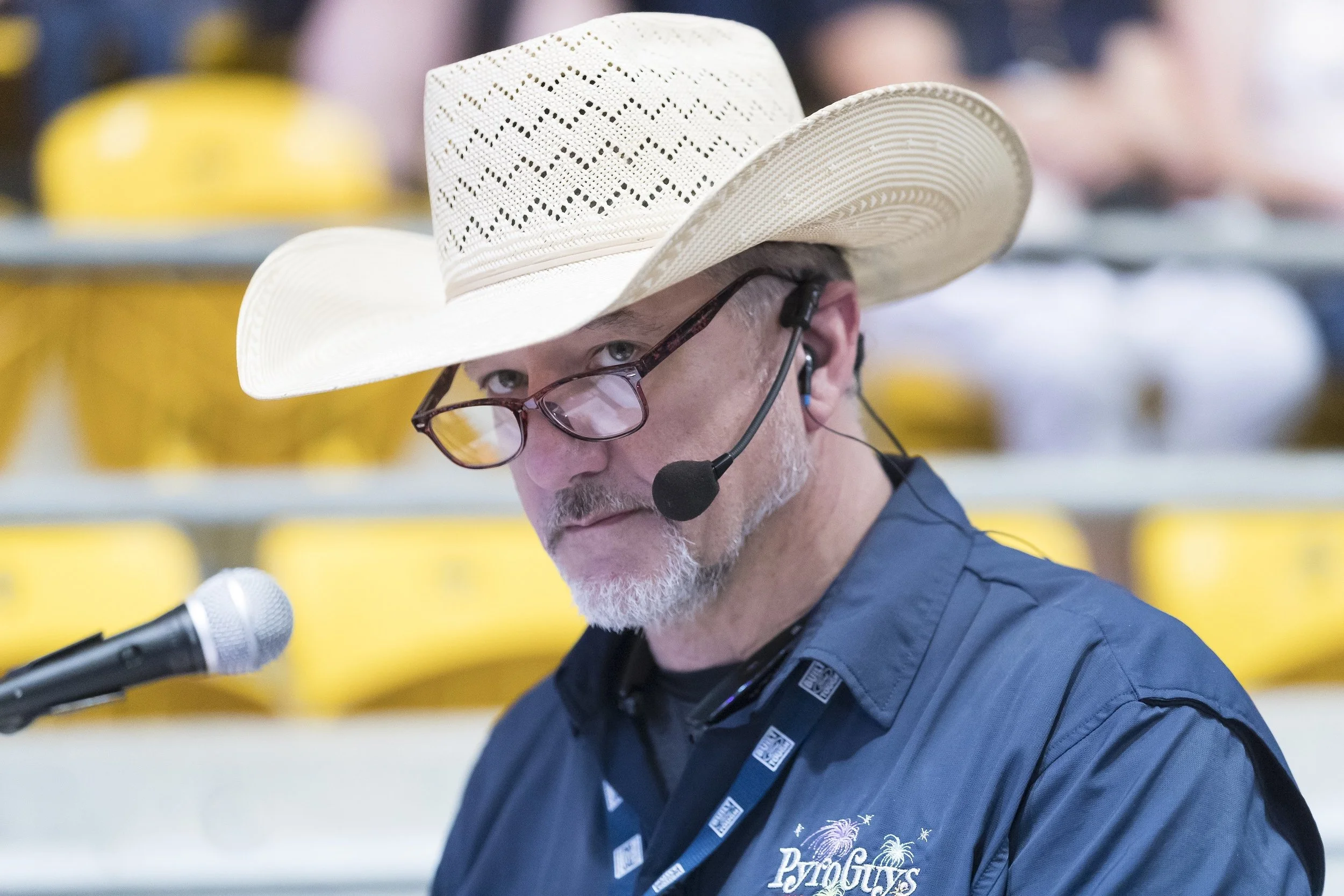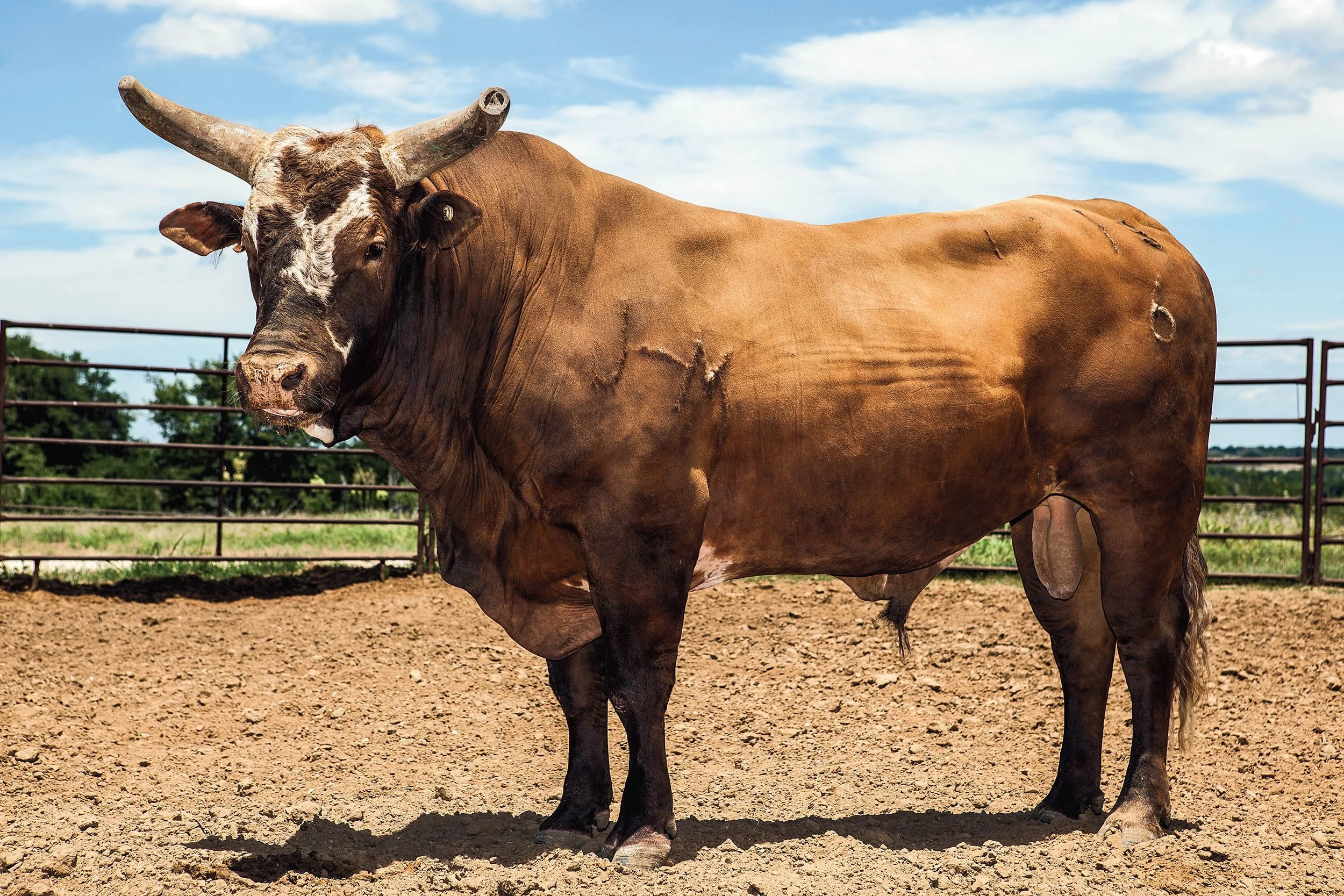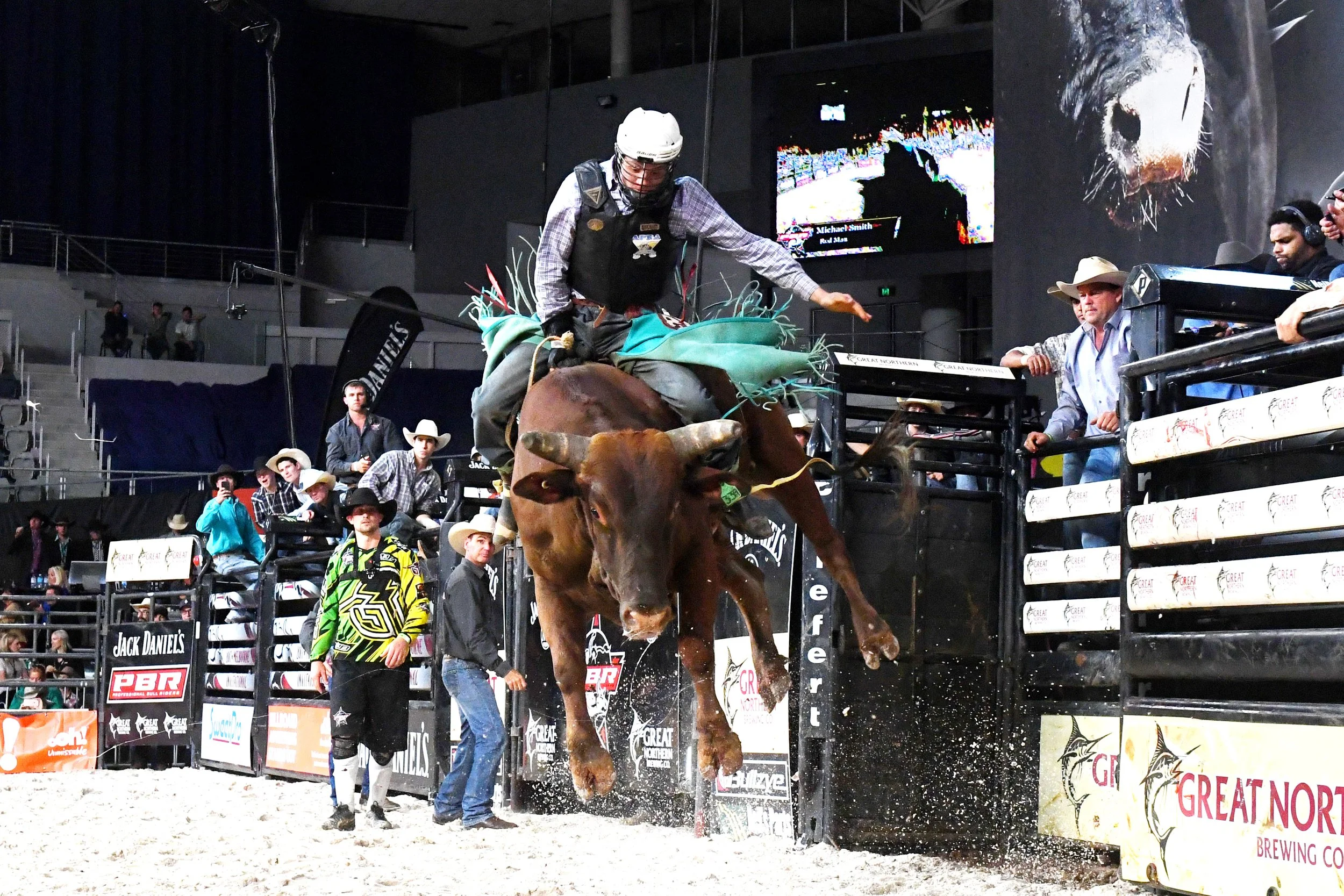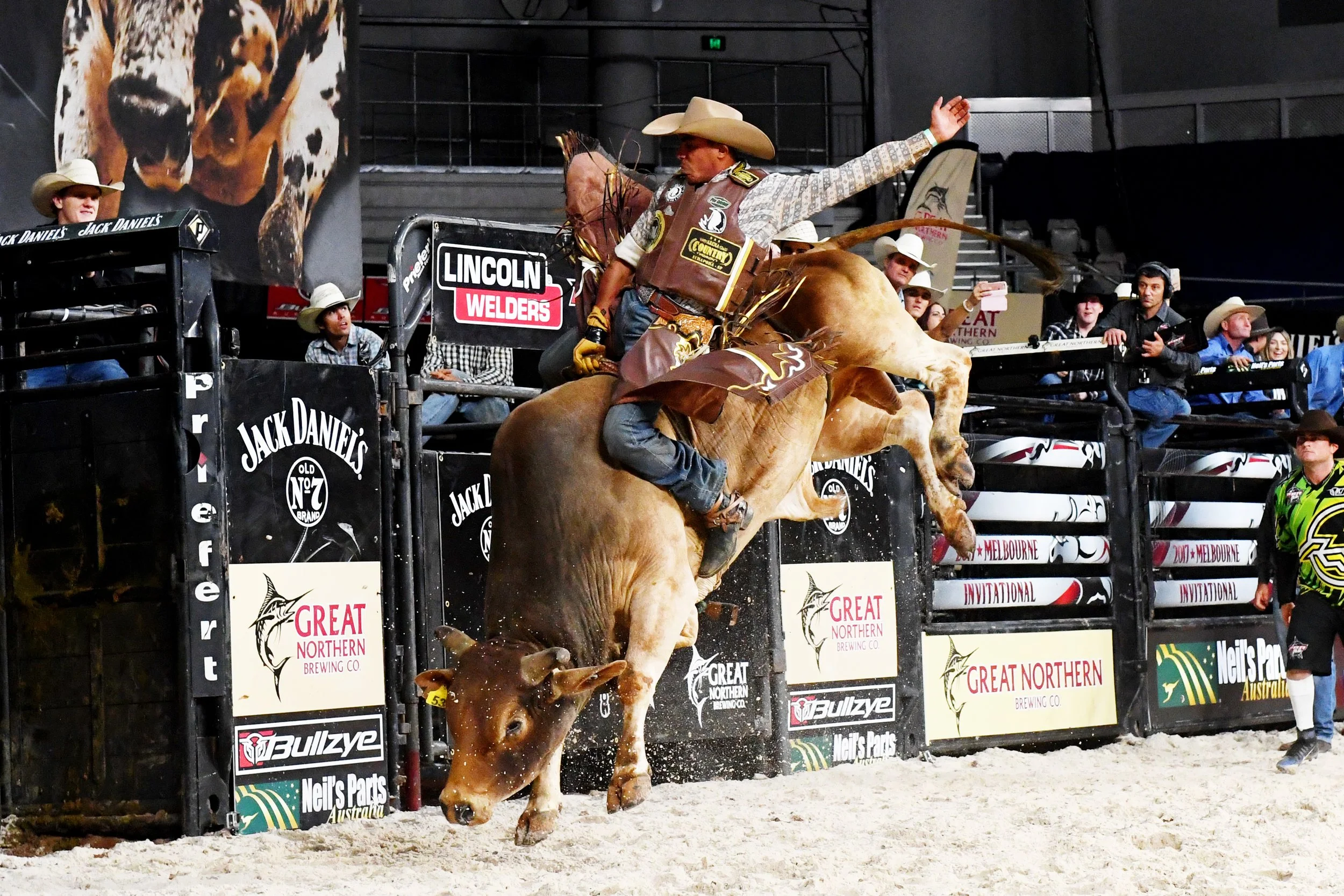Guts and Glory
US PBR Production Manager James White says Australia is on the brink of exponential growth in the sport. Photo: Elise Derwin.
“Our fans are so well educated and they are also helping us educate these PETA people. Every now and again you get one who wants to make a name for himself, but our fans shut them down, and they usually leave.”
Tough day at the office
Billed as the toughest sport on dirt, bull riding today is also a multi-million dollar business — and an example of marketing genius.
Organisers have faced a gruelling and risky road to graduate bull riding into a sport that is no longer about redneck cowboys with more brawn than brains, clowns and crazy bulls.
Today, this is a slick outfit centred around athletes – cowboy athletes, bull athletes, and protection athletes (see below for an explanation). It has been transformed into incredible entertainment that has – in the main – traversed PETA (the animal activism group People for the Ethical Treatment of Animals), while also allowing the best of the best to earn millions doing it.
How has bull riding managed its public relations, and what can dairy take out of it?
PBR — Professional Bull Riding — is unquestionably big business. From the cowboy athletes to the bull athletes, there is extraordinary money available, but of course, there is a lot of ground in between for some competitors that won’t quite pay their bills.
PBR has kicked more goals than many may realise, and its promotors have taken the sport from its small-town country roots all the way to Las Vegas and New York’s Madison Square Garden.
Today, the top bull riders come out of the USA, Brazil, Mexico, Canada and Australia. The national finals rodeo is the season-ending championship event for the Professional Rodeo Cowboys Association (PRCA), and is widely acknowledged to be the world’s premier rodeo — it’s even dubbed the “super bowl of rodeo”. The annual, 10-day event held in Las Vegas, offers an annual prize purse worth more than US$10 million (that’s A$13,105,000 to give an idea on the rest of the figures). In three years, three-time PBR world champion Silvano Alves won US$3.2 million.
The top bucking bulls are household names, known for their temperament and athletic ability, and with as much profile as a pro-fighter. The best are valued at more than US$1million, with semen from the world’s best bucking bulls valued at US$5000/straw. Even mid-range bulls in the US can command US$200,000.
No whacker
The bull that helped change PBR bulls’ profiles was “Bushwacker” – and PBR officials cashed in on his crowd appeal in all the best ways.
Bushwacker was on t-shirts and coffee mugs and he appeared in ESPN the Magazine’s “Body Issue” before his retirement in 2014. (This annual issue of the magazine is where top athletes “strip down and show off their perfect form”.)
Bushwacker always boosted ticket sales and single-handedly drove them in his final appearance in his last world final. Weighing in at almost 800 kilograms, Bushwacker was quick, smart, unpredictable, and let’s not forget … mean.
During his six-year career, he was only ridden twice in 66 outs, earning US$600,000. Most riders could only stay on for 3.3 seconds of the required eight. He was the PBR World Champion Bull for three years. Former Chairman and CEO of the PBR, Jim Haworth, was quoted as saying of Bushwacker’s final outing: “Bushwacker has been a rock star, he’s been on every national TV broadcast. He’s more of a fan favourite than the cowboys. He’s put PBR on the map.”
Bushwacker’s owner Julio Moreno valued the bull at US$2 million in 2014, and told Las Vegas Review Journal’s Alan Snel that year that he had turned down an offer of US$800,000 a few years earlier. Calves sired by Bushwacker sold for US$50,000 to US$100,000 and Moreno had a US$100,000 insurance policy on the bull. At the time of his retirement, Bushwacker had two security guards, in addition to 24/7 video surveillance.
The bull that helped put PBR on the map went by the name Bushwacker. Bushwacker, with his 1m vertical jump, was valued at US$2 million in 2014.
Risk is real
But, glamour aside, this is also a sport where fortunes can change in a millisecond. Granted, that most of the worst injuries happen in the ‘rough-stock’ events of bull, junior bull, steer, saddle bronc and bareback riding.
To be a great bull rider, it’s said one must have the mind of a golfer and the body of a UFC (Ultimate Fighting Championship) fighter. There are no guaranteed salaries in this sport. And, there’s no “if” you get injured, the question is more about the “when” and “how bad” it will be.
Sports epidemiologist with the University of Calgary, Dale Butterwick, created a rodeo injury database. His numbers showed that nearly 20 of every 100,000 rodeo contestants can expect to suffer a catastrophic injury. In football, that rate was less than one in every 100,000 players. “Catastrophic” injuries means a player either died or their life was altered in a significant way. Dale told The Canadian Press: “I haven't seen any sport that comes close to that. In a scientific setting, alarm bells go off.”
Since 1989, there have been 21 deaths on the rodeo circuit, which is more than any other professional sport. Dale Butterwick's study charted 49 catastrophic injuries.
Genomics and changes
However, things are changing.
US riders are today extending their careers because of greater professionalism, training and access to world-class sports medicine. A bull rider, aged in his early to mid 30s used to be considered an “old man”. Today, the oldest bull rider on the circuit is a 40-year-old Brazilian.
Bucking is highly hereditary. The PBR has now established American Bucking Bulls Incorporated (ABBI), which is using genomics to start breeding more proactively for bulls that will buck
And, just like the bulls are born to buck, it seems that the cowboy athletes are born to ride — and there is no shortage of them coming up through the ranks.
“Australia is right on the brink of exponential growth.”
Australian rise
Australia’s PBR is on the rise. It’s one of the four countries outside the USA that is part of the PBR movement, although the other three are far geographically closer — being Canada, Brazil and Mexico.
James White is the US PBR Production Manager. Over the years, he turned away from production jobs in rock ‘n’ roll, because he was a country boy at heart. He’s now been with PBR almost 14 years.
He was in Australia recently to help co-ordinate a series of events that performed to thousands in all the country’s capital cities. James says Australia is about 12 years behind the USA — but is catching up fast.
“Australia is right on the brink of exponential growth,” James says. “The livestock are becoming very high quality — even some of our US bull riders have said that the Australian livestock buck pretty hard.
“And the US guys ride some of the rankest bulls in the world including Bushwacker [who had a one-metre vertical jump], Astroid [2012 World Champion] and Air Time [who had a 31-1 record in his four-year career]. They are some pretty amazing animals.
“I think PBR is one of the best kept secrets in Australia. It could be one of the top sports in the country, easy. The competition is great, fast-paced, it’s a good family show, good entertainment and that’s why I’ve stayed with it this long.”
PETA bucked off
What the PBR has also been able to do – against the odds – is shut down PETA. This is despite that on the outside PBR appears to be the perfect target for the animal activist group.
During the Australian series, a bull named Crime Scene broke his leg and had to be euthanized in Adelaide. As animal activists went to town, PBR issued a press release that – for most part – appeared to end any debate. Since PBR’s inception in 2006, there have been more than 14,500 buck-outs and three bulls have died.
James says, “The bulls here are like family. They are worth a lot of money, so when a bull passes, it’s like a family member dies. They bury them and give them a head stone just like a family member.”
Education working
James White says Australia’s best bulls right now are worth around A$10,000 – and rising fast.
PETA is a subject he has watched unfold in the USA and says PBR’s strategy against the group has mostly been effective.
“We educate them, and our fans. It’s difficult. It’s taken 15 years and there’s still some idiots out there. But we have videos we play, which we call ‘Bullriding 101’. It explains how much we care for our bulls and what the flank rope does – that it’s really just telling the bull it’s game-time.
“By educating the fans and the general public about what we’re doing, it has helped.
“PETA has been in different places, protesting, but we don’t give them the time of day, we don’t acknowledge them, we don’t give them any press and they realised they have no foot hold.
“Our fans are so well educated and they are also helping us educate these PETA people. Every now and again you get one who wants to make a name for himself, but our fans shut them down, and they usually leave. We don’t have to do anything.”
Rookie PRB rider Michael Smith, from Tully in Far North Queensland, finished fourth in the Melbourne event. Photo: Elise Derwin.
From clowns to protection athletes
James says the “protection athletes” – who used to be known as clowns – were today also able to make a full-time living out of protecting bull riders. It’s the same story for bull contractors who breed and develop the bucking bulls.
He predicts big things for the sport in Australia because of the rugged riders and country culture.
“On all levels it’s becoming more watched,” he says. “The crowds are getting bigger and better and once Australia catches on to bull riding there’s nowhere to go but up. It has a bright future, it’s growing fast.”
Locals doing well
Right now, talented bull riders in Australia all target the US lucrative professional circuit. Twenty-year-old Michael Smith is no exception. The Far North Queenslander, from Tully, is riding professionally in his first year of PBR. He hopes to be in the USA competing next year. Michael’s father rodeoed and Michael says he grew up around horses and cattle. He says: “It was probably natural that I was going to ride bulls.”
Michael had a strong performance in Melbourne recently, in a field that included two internationals at a near sell-out crowd at HiSense Arena.
It was his biggest event to date and he was in the running for second until his final ride. Michael went into the final round with 165.75 points, just behind the leader Brazil’s number-two rider, Lucas Divino, who was on 167.25. The South American went on to win and the young Australian finished fourth.
Michael, who likes bulls that kick and spin for the whole eight seconds says he was still learning to conquer his nerves.
“I’m not nervous about the bulls because I’ve been doing it a long time,” he said. “It’s more about my performance because I’ve come a long way and everyone is trying to get points and I don’t want to underperform.”
He thinks the goals of all Australian riders is to go to the USA.
“Take it as far as you can. May as well. If we earn enough points in Australia it is a pathway to the bigger events in America. By this stage next year, I’d like to be on the Velocity level in the USA.”
Brazil’s Lucas Divino has been in winning form in Australia. Photo: Elise Derwin.
Lesson for dairy
In among all the excitement, swirling dust and adrenalin, there is a stand-out message for other industries: PBR didn’t start with a multi-million dollar budget and it had to learn fast to survive. The people involved all grew up around the sport and understand it from the ground up and are passionate about its success and survival.
PBR and its worldwide networks treat their animals with incredible respect, but they turned that into a great public relations message, which has, in turn, “personalised” the bulls and educated the fan-base. Spectators have responded by flocking to events, to not only see their favourite riders, but, tellingly, they have identified with their favourite bulls.
It is an outstanding public relations effort that has been nurtured at every level by the right people. And, so the PBR juggernaut keeps rolling.
It’s hard to imagine that there isn’t an epic marketing lesson in there for the dairy industry that has been missed – both by many of Australia’s farmers who need to treat their animals impeccably, and by the bodies entrusted to showcase the Australian industry so that our customers understand our story too.
